
Hi everyone! This time I want to try to participate in a task given by professor @sachin08 from the Steemit Crypto Academy community. The professor gave several questions related about Wedge Pattern.

Question 1
Explain Wedge Pattern in your own word
We all know that there are so many types of Candlestick Patterns that have been discovered today. All of these patterns are made to support traders in trading in the cryptocurrency market, one candlestick pattern that can be learned to trade on the cryptocurrency market is Wedge Pattern.
Wedge Pattern is a candlestick pattern that has its own distinctive shape, this pattern will be easy to see if we draw 2 lines at the upper and lower limits of the highest and lowest points of the price that a cryptocurrency has reached. The lines I mention here are Resistance Level and Support Level. When these two lines are drawn at certain points, then we can see that the candlestick forms a conical-like pattern where the end of this pattern will be smaller than the beginning.

When this pattern is formed, it will indicate a trend reversal that will occur in the cryptocurrency market. So the Wedge Pattern is often used by traders to see where is the right time or moment to enter a trade when the trend in the market is reversing and they can enter at the most ideal price.
Wedge patterns are often found when they are at the top of a trend. If the trend in the market is bullish then it will often be at the highest price in that period. Meanwhile, if the market is experiencing a Bearish Trend then it will be at the lowest price at that time.
However, this closes the possibility that we will get the Wedge Pattern in the middle of an ongoing trend, sometimes we get this pattern in the middle of the trend and we can also use it as a signal for the continuation of a trend.
The Wedge pattern also has 2 different types of patterns, where these two types of patterns have their own characteristics, each of which will be used in different conditions, I will explain in more detail in the next discussion.

Question 2
Explain both types of Wedges and How to identify them in detail. (Screenshots required)
As I mentioned in the previous discussion that the Wedge Pattern has two different types, namely Falling Wedge and Rising Wedge, these two types of Wedge Patterns have their own characteristics and will be used at certain moments.
1. Falling Wedge
Falling Wedge is a Wedge Pattern that occurs when the trend in the market is Bearish, this pattern will be formed when the two trendlines drawn at the upper and lower limits of the candlestick taper and go downwards. Generally, we will often get this type of Wedge Pattern at the lower end of a trend, although it is possible that this pattern will also form in the middle of the trend.
When the Falling Wedge Pattern is formed, then when the candlestick breaks out with the trendline, it will indicate that the Bearish Trend in the market will experience a trend reversal to become a Bullish Trend.
To identify the Falling Wedge Pattern, we need to pay attention to several conditions that must be met so that the pattern formed on the candlestick is truly a Falling Wedge Pattern, the requirements are as follows.
| The trend is in the Bearish Trend. | |
| The two trendlines (Resistance Level and Support Level) should be sloped downwards. | |
| The trading volume that occurs in the market is experiencing a decline. | |
| The candlestick must touch a total of at least 5 times on the Resistance Level and Support Level. | |
| There should be no breakout before the candlestick touches at least a total of 5 times on the Resistance Level and Support Level. |
For more details, let's look at the example graph below.
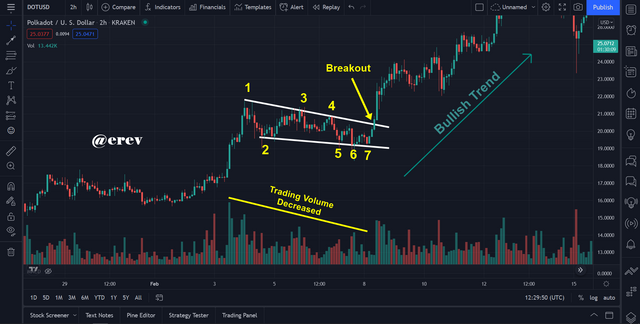
In the picture above we can see that the candlestick made a pattern where it began to experience a decline in price and the movement of the candlestick began to taper at the end of the pattern so I drew two trendlines at the top and bottom as Resistance and Support Levels. Then I saw that the candlestick had touched the two trendlines for a total of 7 times including 3 times at the Resistance Level and 4 times at the Support Level before finally Breakout with the Resistance Level.
And plus the Volume indicator shows that there is a decrease in trading volume that occurs in the DOT/USD market, so with all of this it has been proven that the pattern created in the DOT/USD market at that time was Falling Wedge Pattern. After that we can see that the trend that was initially experiencing a Bearish Trend has turned into a Bullish Trend.

2. Rising Wedge
Rising Wedge is a Wedge Pattern that is inversely proportional to the Falling Wedge previously discussed, this pattern occurs when the trend in the market is bullish and this pattern will be formed when the two trendlines drawn at the upper and lower limits of the candlestick are tapering and towards the top. Generally, we will often get this type of Wedge Pattern at the top end of a trend, although it is also possible that this pattern will form in the middle of the trend.
When the Rising Wedge Pattern is formed, when the candlestick breaks out with the trendline, it will indicate that the current Bullish Trend in the market will experience a trend reversal to become a Bearish Trend.
To identify the Rising Wedge Pattern, we need to pay attention to several conditions that must be met so that the pattern formed on the candlestick is truly a Rising Wedge Pattern, the requirements are as follows.
| The trend is in a Bullish Trend. | |
| The two trendlines (Resistance Level and Support Level) should slope upwards. | |
| The trading volume that occurs in the market is experiencing a decline. | |
| The candlestick must touch a total of at least 5 times on the Resistance Level and Support Level. | |
| There should be no breakout before the candlestick touches at least a total of 5 times on the Resistance Level and Support Level. |
For more details, let's look at the example graph below.
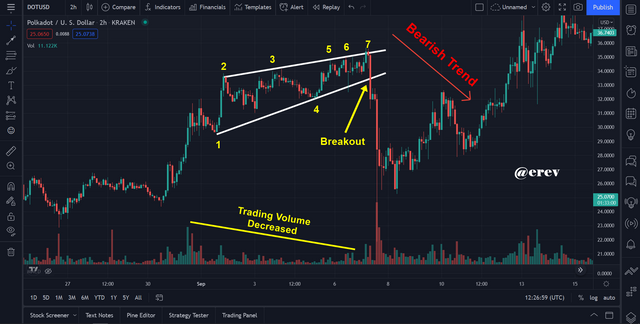
In the picture above we can see that the candlestick made a pattern where it started to increase in price and the movement of the candlestick began to taper at the end of the pattern so I drew two trendlines at the top and bottom as Resistance and Support Levels. Then I saw that the candlestick had touched the two trendlines for a total of 7 times also the same as in the Falling Wedge example. He touched 5 times on the Resistance Level and 2 times on the Support Level before finally Breakout with the Support Level.
Then the Volume indicator also shows that there is a decrease in trading volume that occurs in the DOT/USD market, so with all of this it has been proven that the pattern created in the DOT/USD market at that time was Rising Wedge Pattern. After that we can see that the trend that was initially experiencing a Bullish Trend has turned into a Bearish Trend.

Question 3
Do the breakout of these Wedge Patterns produce False Signals sometimes? If yes, then Explain how to filter out these False signals
My answer to this question is Absolutely. Just like other types of candlestick patterns. The Wedge Pattern can also give a false signal, the false signal given is often a signal where the Wedges Pattern gives an indication of a trend reversal that will occur in the market when the Candlestick breaks out with one of the trendlines, but apparently there is no change in any trend in the cryptocurrency market. , otherwise the trend will resume its direction. To be clearer, let's look at the example of the cryptocurrency graphic image below.
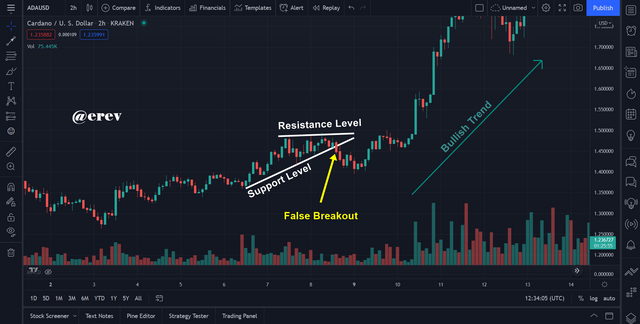
We can see in the ADA/USD chart image above, the candlestick shows a Rising Wedge Pattern formed on the chart, so I drew 2 trendlines at the upper and lower limits. After that the candlestick breaks out with the Support Level which is the lower limit so that the Rising Wedge Pattern gives a signal that the trend will reverse to become a Bearish Trend. However, it didn't really happen where we can see that the ADA/USD market only experienced a price correction for a while and continued its Bullish Trend.
From this we can see that the Wedge Pattern does not always give accurate signals and often it gives false signals. To minimize false signals like this, we can use the help of indicators to first analyze the signals given by the Wedge Pattern before finally making a decision to enter into a trade. In this example I will use the Moving Average Indicator as a filter for false signals from the Wedge Pattern, I use the MA indicator with a length of 60 so that the average price movement taken is more accurate, let's look at the example below.
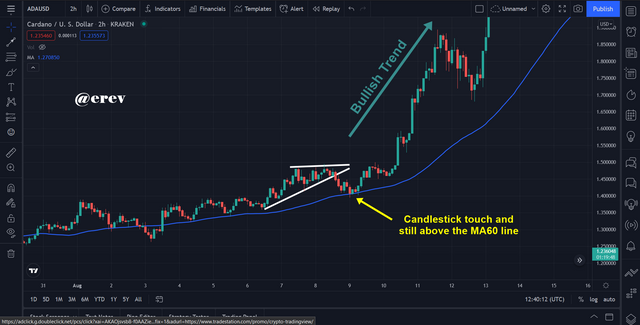
In the picture above you can see that I have added an MA indicator with a length of 60 on the chart which is shown by a green line. Then we can see how the MA can filter out the false signals given by the Wedge Pattern.
After the candlestick breaks out with the Support Level indicating a change in trend to a Bearish Trend, it does not go straight down sharply and does not cross the MA60 line, as long as the cadlestick is still above the 60 line which is another support Support Level, then there is a Bullish Trend in the market. ADA/USD is still not over. And indeed it is proven where the Bullish Trend in the ADA/USD market is still continuing and even the price of Cardano has experienced a very sharp increase in price.

Question 4
Show full trade setup using this pattern for both types of Wedges.( Entry Point, Take Profit, Stop Loss, Breakout)
So that we can use this Wedge Pattern well, now I will practice how to use both types of Wedge Pattern in the right way.
1. Rising Wedge
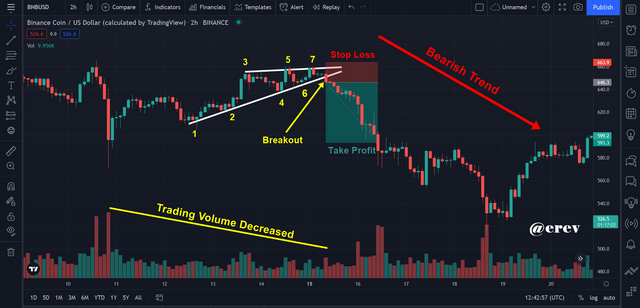.png)
The first example is Rising Wedge Pattern, in this example I use BNB/USD market with 2 hour timeframe. I saw a candlestick on the BNB/USD market showing the formation of a Rising Wedge Pattern where the candlestick gradually began to taper upwards, after I drew two trendline lines I also found that the candlestick had touched a total of 7 times on both Trendlines before the breakout, where 3 times touching the Resistance Level and 4 times touching the Support Level. Then the volume indicator also shows a significant decrease in trading volume from the BNB/USD market. All of these things are enough to prove that the pattern formed is the Rising Wedge Pattern.
At the time of the candlestick breakout with the Support Level, I began to decide to enter the trade at that moment. Then I made my trading Risk/Reward Ratio of 1:3 where the Stop Loss Level was above the Resistance Level to be precise at the price of $663.9. As for the Take Profit Level, I put it below the lowest limit of the Support Level, which is at the price of $593.3.

2. Falling Wedge
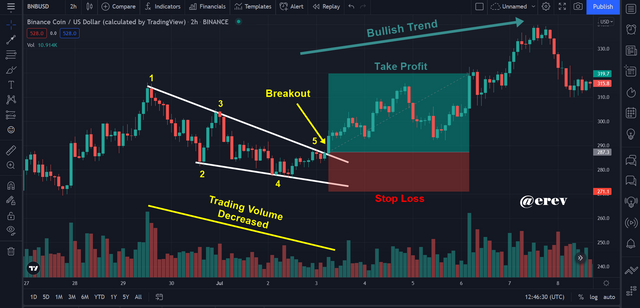.png)
The second example is trading using Fallling Wedge Pattern, in this example I'm still using BNB/USD market with 2 hour timeframe. I saw a candlestick on the BNB/USD market showing the formation of a Falling Wedge Pattern where the candlestick gradually began to taper downwards.
After I drew two trendline lines I also found that the candlestick had touched a total of 5 times on both Trendlines before the breakout, where 3 times touching the Resistance Level and 2 times touching the Support Level. Then the volume indicator also shows a significant decrease in trading volume from the BNB/USD market. All of these things are enough to prove that the pattern formed is the Falling Wedge Pattern.
At the time of the candlestick breakout with the Resistance Level, I began to decide to enter the trade at that moment. Then I made my trading Risk/Reward Ratio of 1:2 where the Stop Loss Level was below the Support Level to be precise at the price of $271.1. As for the Take Profit Level, I put it above the highest limit of the Resistance Level, which is at the price of $319.7.

Conclusion
Trading using the Wedge Pattern is a quite unique trade, from this lesson I saw that this pattern is a candlestick pattern that is quite capable of showing trend reversal signals in the cryptocurrency market. Even so, we must also pay attention that this pattern can still provide false signals that can trap us in the decision-making process in trading in the cryptocurrencies market. Help from other indicators is needed to support our success in trading using the Wedge Pattern, because these indicators can help us filter out false signals given by the Wedge Pattern.
In addition, we must also be careful in indicating the types of Wedge Patterns that are formed in the cryptocurrency market, lest we are wrong in drawing the trendline and cannot distinguish which is the Rising Wedge Pattern and which is the Falling Wedge Pattern because both types of patterns will be used in different conditions in seeing the trend reversal in the market.
I thanks for professor @sachin08 who has given lessons on a very unique topic like this, I really get new knowledge from this given topic.